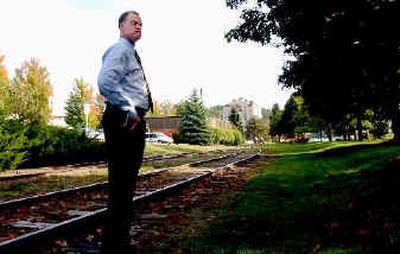Railroad to rip out some track in CdA

As drivers sped across the Mullan Road railroad crossing in downtown Coeur d’Alene Thursday afternoon, not a single one looked to see if a train was coming.
That’s exactly why city officials are overjoyed that the seldom-used tracks are finally leaving town.
“This is like having a junk car right in the middle of our park,” said city attorney Mike Gridley as cars zoomed past the Mullan Road crossing.
Coeur d’Alene signed an agreement with Burlington Northern and Santa Fe Railway this week to remove about a quarter-mile of railroad track that runs parallel to City Park, across Mullan Road and just past Memorial Field. The railroad will also take out two sets of track that run past the city skateboard park to Park Avenue.
Gridley, who has been negotiating the agreement for more than a year, said the track removal will improve safety and give the city numerous options for providing more public space, whether it’s more city parks, a larger human rights center or parking for North Idaho College. It’s all part of Coeur d’Alene’s idea for revitalizing the Four Corners area, which includes City Park, Independence Point and Memorial Field.
It’s also a start to the city’s grand plan to create an educational corridor, which means eventually removing all the track from Memorial Field north to the new Riverstone Development near the Interstate 90 interchange, and relocating Stimson Lumber Co.’s DeArmond mill.
The removal of the Mullan Road crossing should start early next week and take two weeks to finish. Gridley expects the crossing to be closed for an entire day, but he’s unsure when and how the city will reroute traffic.
The city agreed to pay $79,000 for the removal, much of which will go to replacing the switch next to Memorial Field. Four separate tracks run from the sports field north past the skate park to the DeArmond mill. Two tracks will remain, giving the railroad a place to store rail cars.
The money will come from the city’s pocketbook and potentially from the Lake City Development Corporation, the city’s urban renewal agency. Grants are another possibility.
Gridley said the Mullan Road crossing is a safety concern because people are used to not having trains on the tracks. That’s a dangerous habit because when drivers come across a live railroad crossing, such as on the Rathdrum Prairie, they are less likely to look, he said.
“It’s an unsafe situation and we need to correct this,” said Gridley, a former Union Pacific Railroad attorney. “It’s imprinted in people’s brains that they don’t need to stop at a crossing.”
The other safety concern is with pedestrians tripping over the tracks as they try to get to City Park. This summer Gridley sent BNSF officials a video of pedestrians trying to cross the tracks and drivers failing to look at the Mullan Road crossing.
“It’s part of our ongoing relationship to work with the community,” BNSF spokesman Gus Melonas said.
The track removal is also a key part of the city’s revitalization plans for the Four Corners area.
In January, the Committee of Nine, a volunteer board, presented the City Council with conceptual drawings for revamping the area, where people get the first glimpse of Lake Coeur d’Alene as they enter downtown.
So far, there are no specifics, just ideas. And now that the tracks are leaving, one of those ideas is a larger space for a human rights center that is being planned by the Human Rights Education Institute. The institute wants to build the center at the edge of the park where the old brick powerhouse, which was recently a cultural center, sits.
“This is very exciting,” said Mary Lou Reed, chairwoman of the human rights center committee. “The city will be able to have more flexibility for use of that property. It just opens up possibilities.”
Other ideas include relocating the Museum of North Idaho to the north side of Mullan Road near Memorial Field, and reconfiguring and expanding the skate park.
The tracks, which Gridley thinks may be a 100 years old, are rarely used and Gridley can’t remember the last time a train crossed Mullan Road. It may have been in August 2001, when the Western Governor’s Association met and some rail cars were parked near the museum.
Initially, the city wanted the tracks removed in time for June’s Ironman triathlon, but that didn’t happen. Gridley said it was mostly because BNSF requires so many people to sign off on the deal.
Councilman Al Hassell, a former mayor, said the city has been working on getting the tracks removed for as long as he can remember.
“It’s always been a hazard,” Hassell said.
He said it will take a lot of planning to finalize how the city will use the freed-up property.
“It’s a great opportunity for the city to expand the public area,” he said.